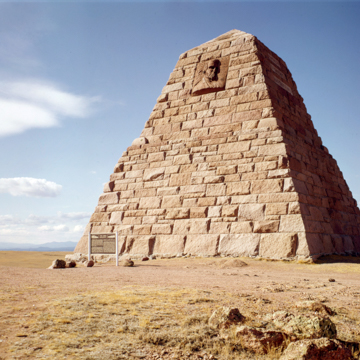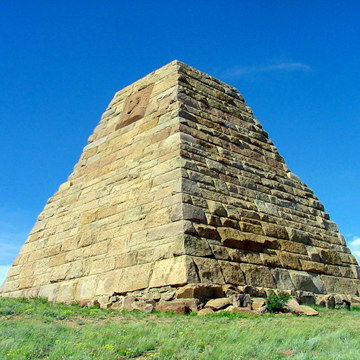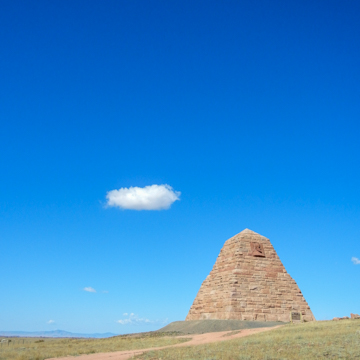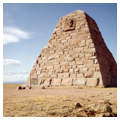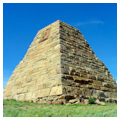The Ames Monument was designed by H.H. Richardson for the Union Pacific Railroad to honor Oliver and Oakes Ames, brothers who were largely responsible for the completion of the transcontinental railroad. The massive pyramid rising from a windswept, treeless summit about 20 miles southeast of Laramie, was sited at an elevation of 8,247 feet, 30 feet above and 300 feet away from what was then the highest point on the Union Pacific Railroad. The railroad right-of-way has since been moved several times, but the setting of the monument remains much as it was more than 130 years ago. The area is marked by unusual rock formations and Richardson designed the Ames Monument to fit into the landscape. Nonetheless, the sight of a 60-foot-tall, man-made mountain in this remote area is jarring. The Ames Monument is the only structure Richardson designed west of St. Louis.
In the stark simplicity of its design, the scale of its rock walls, and the surface texture, the pyramid recalls other Richardson designs, such as the Billings and Crane Memorial Libraries and the Marshall Field’s Wholesale Store. But with the Ames Monument, Richardson produced a pure architectural form, free from program. The four-sided pyramid is 60 feet square at its base, and rises 60 feet in height. The base is composed of evenly coursed, roughly 5 x 8-foot, rusticated ashlar granite blocks, while the subsequent courses, which batter upward at a slope of 4 inches to the foot, are randomly coursed and less uniform in size and projection. About 27 feet from the base is a slight set back, with smooth, rounded corner blocks at the four corners. Above, the stone is evenly coursed and continues at the same slope until 7 feet from the top, at which point the four sides of the pyramid come rapidly to a point, forming a cap. The battering, setbacks, and subtle changes in masonry courses, as well as the fine craftsmanship, give the monument its distinctive proportions and sculptural interest.
For the Ames Monument, Richardson collaborated with artists and craftspeople he had worked with many times before, including Augustus Saint-Gaudens and the Norcross Brothers. Near the top of the structure, on the east and west sides respectively, are 9-foot-tall inset panels with bas-relief portraits of Oakes and Oliver Ames, sculpted by Saint-Gaudens and carved in sandstone by architectural craftsman John Evans. The panels were created in Massachusetts, brought to the site by train, and integrated into the masonry walls. A panel on the north side of the monument, which originally faced the passing trains, reads, “In Memory of Oakes Ames and Oliver Ames” in one-foot-high capital letters.
For construction Richardson turned to his primary contractor, the Norcross Brothers of Worcester, Massachusetts. The Norcross Brothers’ crew of 85 workers quarried the granite from a nearby outcropping known as Reed’s Rock, cut and dressed it on site, and assembled the pyramid. The monument is essentially hollow, with a perimeter passageway and an internal masonry framework that helps support the load-bearing walls.
Industrialists from Massachusetts, the Ames brothers were responsible for the increased pace of construction of the railroad after they became major investors and assumed key leadership roles shortly after the Civil War. Their business dealings were controversial and Oakes was involved in a lawsuit over corrupt business practices, from which he was eventually vindicated by a Supreme Court decision—but not before he died. In 1875, the Union Pacific voted to fund construction of a memorial for Oakes Ames, “in recognition of his services in the construction of the Union Pacific Railroad to which he devoted his means and his best energies with a courage, fidelity, and integrity unsurpassed in the history of railroad construction.” The Union Pacific spent liberally on the monument, one of the largest and most expensive private monuments in the country.
While obviously memorializing the Ames brothers and reflecting the power of the Union Pacific, the Ames Monument also represents the nationally transformative impact of the railroad as a massive infrastructure project in the years following the Civil War. Ultimately, though, perhaps the monument is best appreciated as a master work of art by one of the most creative minds of the day. Architectural historians have consistently viewed the Ames Monument as one of Richardson’s finest works. In The Architecture of H.H. Richardson and His Times, Henry-Russell Hitchcock described the Ames Monument as “perhaps the finest memorial in America” and as one of the architect’s “most perfect works.” Visiting the structure soon after its completion, Frederick Law Olmsted wrote, “I never saw a monument so well befitting its situation or a situation so well befitting the special character of a particular monument.”
In 1983, the Upland Industries Corporation, Union Pacific’s land development subsidiary, donated the Ames Monument and 8.44 acres to the state of Wyoming, which manages it as a state historic site.
References
Allabeck, Sarah, Ethan Carr, and James F. O’Gorman. “Ames Monument,” Albany County, Wyoming. National Historic Landmark Nomination form, 2015. National Park Service, U.S. Department of the Interior, Washington, DC.
“Ames Monument, HABS. No. WYO-72,” Written Historical and Descriptive Data. Historic American Buildings Survey, Washington, DC, 1977.
Junge, Mark, “The Ames Monument,” Albany County, Wyoming. National Register of Historic Places Inventory – Nomination Form, 1971. National Park Service, U.S. Department of the Interior, Washington, DC.














